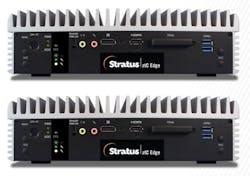Edge Computing for Industrial Control Systems
The advantages of cloud computing for industrial applications are increasingly finding themselves equally weighted—if not somewhat less favored—with the advantages of edge computing. Both offer systems for storage and analysis of data, but edge computing offers its advantages on site and even on machine. Whereas cloud computing, with all its benefits, raises bandwidth and latency issues in addition to the offsite storage of data, which remains a concern for some companies.
Read more about Edge and Fog computing.
At this point in the evolution of these storage and analysis technologies, the option increasingly chosen today by most companies is a hybrid application of edge and cloud computing. In these hybrid environments, critical production and near real-time data stays onsite for rapid analysis and insights, while segments of filtered data go to the cloud for longer-term trend analysis and decision-making.
Responding to the rising interest across industry for edge computing, Stratus Technologies unveiled its new Stratus ztC Edge at the ARC Industry Forum 2018. According to Stratus, ztC Edge is a zero-touch, fully virtualized and self-protecting edge computing platform specifically designed for industrial control system environments.
The zero-touch computing (ztC) reference stems from the product’s automated application and data recovery, automated site recovery, and cloud-based health monitoring and built-in remote management services. Jason Andersen, vice president of business line management at Stratus, said that the installation wizard and management utility that comes installed on ztC Edge makes it “easy for operational technology staff to set up, configure and manage the virtual machines, which means that little or no resources from corporate IT are needed. In addition, ztC Edge’s virtualization host software can be updated while the system is running without requiring a system reboot.”
Expanding on the ztC Edge’s need for little or no IT support, Andersen noted that the product was designed to address a major edge computing issue in industrial control environments. “Most high availability edge computing solutions in this space are very high end, complex, clustered systems that take at least four hours to install, require significant IT resources and cost $40,000-$50,000. Using standalone industrial PCs (IPCs), plus a spare for redundancy, is a less complex way to approach this, but offers only low to moderate availability and still takes a few hours to install and requires regular backups. And once you add in all the software costs associated with the IPC approach, it costs about same as ztC Edge (in the $12,000-$15,000 range), but the IPC requires a lot more work. ztC edge, however, can be deployed in less than 30 minutes.”
The fanless ztC Edge, which can operate on ac or dc power and run up to three virtual machines (VMs) on different apps, is sold in pairs to support each other. “The paired devices—comprised of redundant nodes that act as a single system—automatically synch with each other for hot swappable, full redundancy,” Andersen said. Along with live migration of VMs, data replication and redundant networking, ztC Edge provides protection for applications and data by continually monitoring itself to evaluate its health and performance. If ztC Edge detects a potential central processing unit or memory failure in one node, it moves VMs from that node to another to provide application continuity.
Andersen pointed out that Stratus’ cloud-based system health monitoring and management services ensure that applications on a customer’s ztC Edge systems are always running, with minimal customer effort. He added that ztC Edge can be configured to continually monitor and send system-generated logs to Stratus over a secure network, where the logs will be analyzed for triage alerts and to predict failures before they occur. Depending on the service level chosen by the customer, Stratus will initiate corrective action—including the shipment of a spare part, conduct a root cause analysis, or prepare a failure prevention plan.
Discussing the application factors used to determine whether Stratus’ ztC Edge or ftServer is the right choice, Andersen said that Stratus relies on tag count to help make the initial determination. “A 10,000 data point industrial control system is a typical site benchmark for ztC Edge,” he said. “With a line typically accounting for up to 10,000 tags, that line can be handled by a pair of ztC Edge computers. At a water/wastewater site, one pair could serve the whole facility. Once you start getting beyond 10,000 data points, that's when the ftServer makes more sense.”
Beyond handling of data points, Anderson said the major differences between the ftServer and the ztC Edge are the OS—ftServer uses a native OS, while ztC Edge runs Linux—and the size. ztC edge weighs 10 pounds, versus the ftServer which weighs in at 110 pounds.
ztC Edge is expected to begin shipping in May 2018, with orders accepted in March.

